Rubus fruticosus agg.
There’s nothing like picking a plump, juicy-looking blackberry from the vines in your own yard and popping it into your mouth.
The tart, sweet flavor of homegrown blackberries is unbeatable. But, you might be wondering, how exactly do you grow these berries at home?
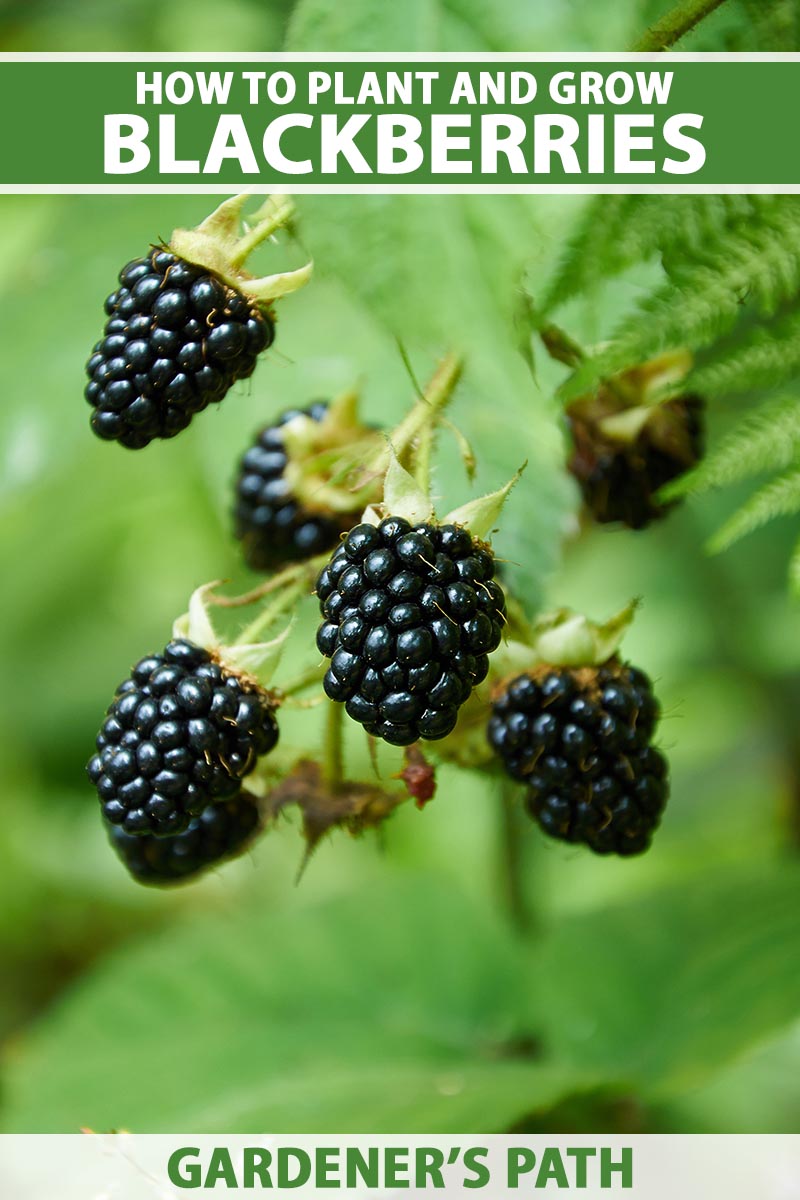
We link to vendors to help you find relevant products. If you buy from one of our links, we may earn a commission.
If you’re wondering whether you’d be able to grow enormous berries like the ones you see in the store, or if they’d be smaller, or how long the lovely fruits have been around, you’ve come to the right place.
In this guide, we’ll dive into everything you’ve ever wanted to know about growing your own blackberries.
Here’s what I’ll cover:
What You’ll Learn
What Are Blackberries?
Blackberries are members of the Rosaceae family, along with such delightful plants as raspberries, roses, and apple trees.
Like closely related raspberries, blackberries are brambles: they’re usually thorny, grow thick and tangly, and can be upright or sprawling.
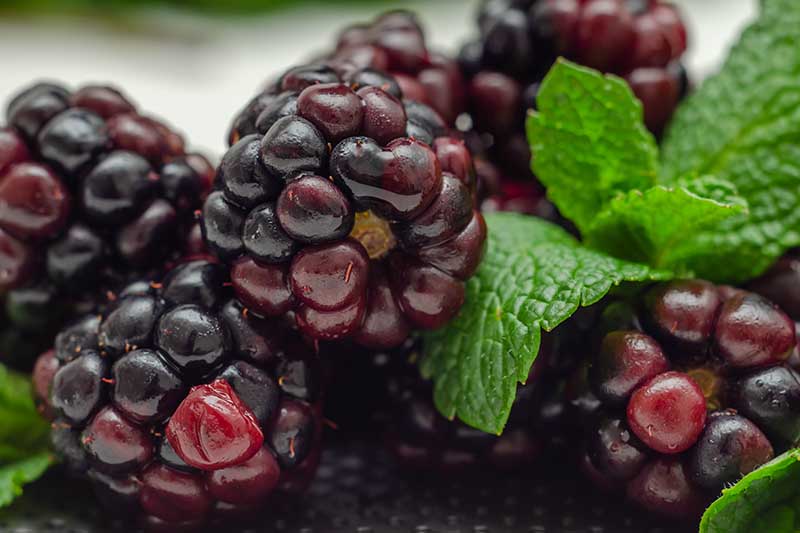
The fruits are not true berries at all, but rather, aggregate fruits made up of small round drupelets. Unlike raspberries, blackberries keep their core intact when picked.
Blackberries are perennial plants that bear fruit on biennial canes. They grow new green stems, known as primocanes, every year, and these typically bear leaves but not flowers on what are known as “floricane fruiting” plants.
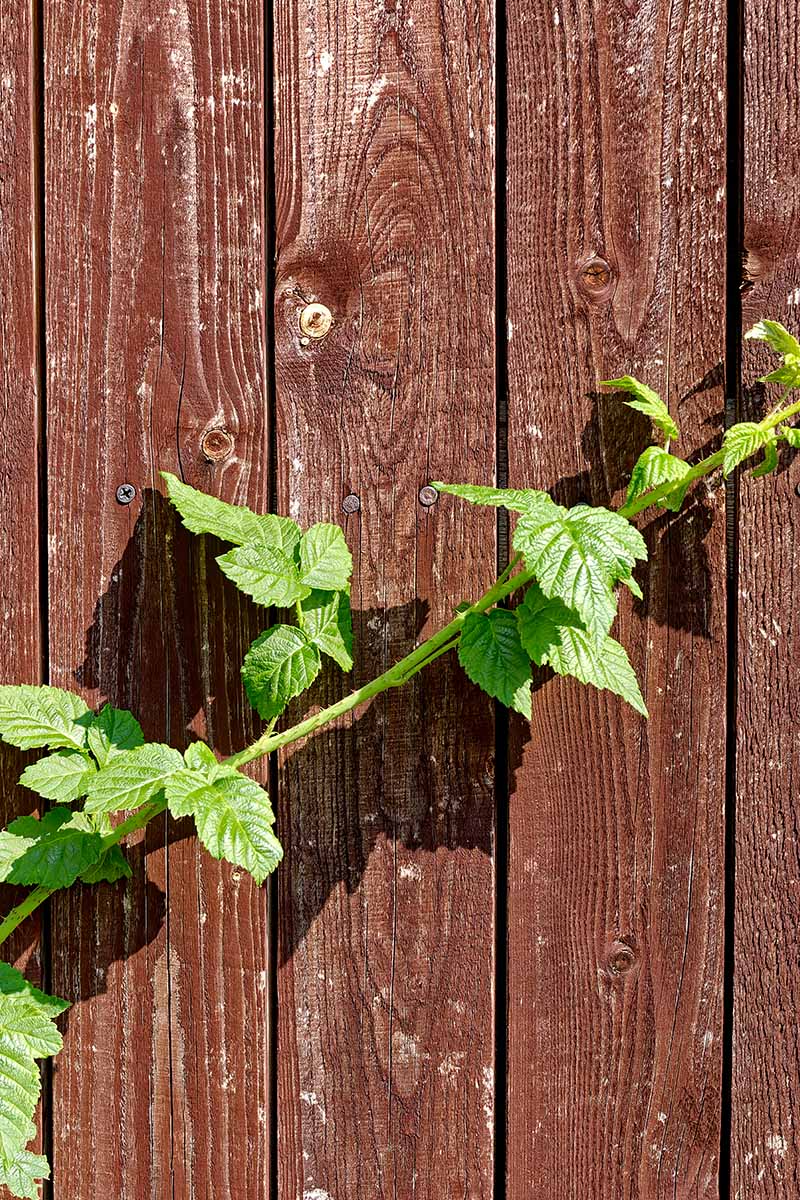
In the second year, these primocanes become floricanes. They turn woody, sprout leaves and new stems from lateral buds branching off the main stem, and produce flowers on those lateral stems.
The flowers then become those irresistibly juicy, sweet-tart berries. After this, the floricanes die.
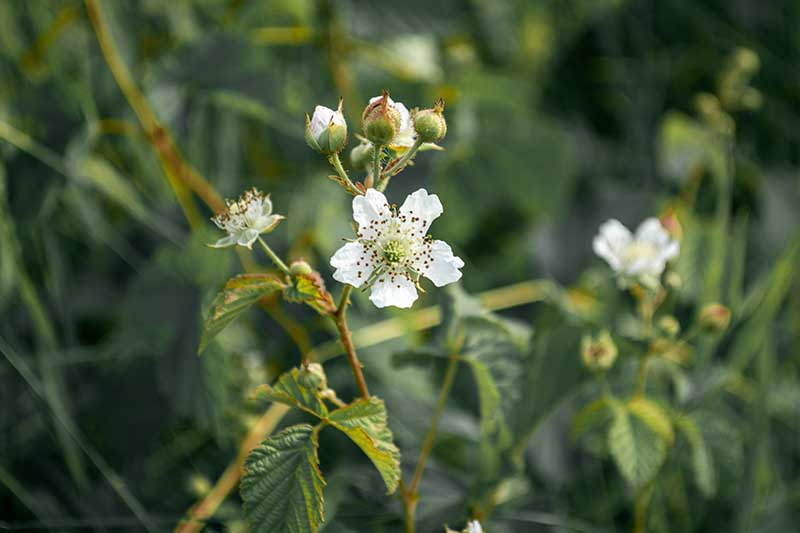
Blackberries are self-fertile, which means pollen from one plant can fertilize the same plant – there’s no need to plant another variety nearby for cross-pollination purposes.
But these berries are not self-pollinating: they require bees and butterflies to help transfer pollen from one flower to another.
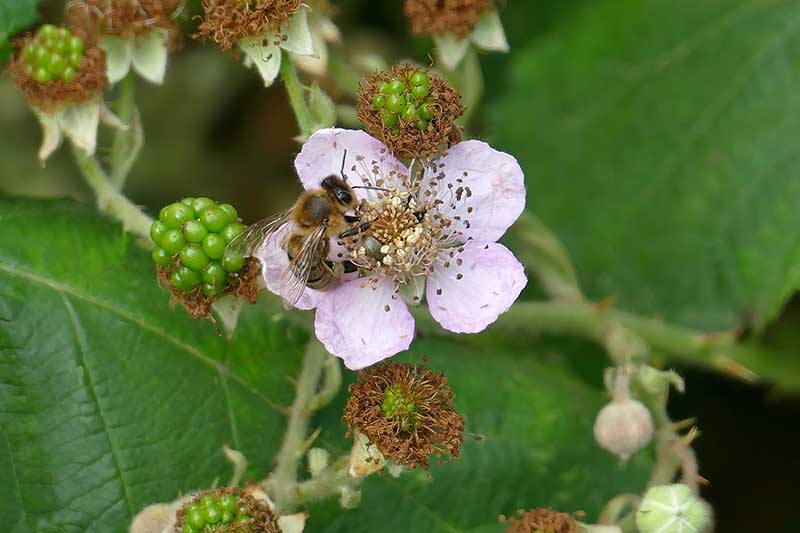
These fruits can be grown in USDA Hardiness Zones 4-9. Many varieties have prickles, but some have been bred to be thornless.
Though rare, a newer breakthrough in blackberry breeding, primocane-fruiting varieties, also called “fall-bearing” blackberries, bear a small crop the first fall after being planted from a bare root, with a full crop following in the second year.
Blackberries prefer loamy, well-draining soil with a pH of 5.5 to 7.0, and thrive in a full sun location with six to eight hours of direct sunshine.
Their average height and spread varies widely, but in general, you’ll need to place each plant about three to five feet apart if you plan to grow more than one.
There are three different plant structures when it comes to blackberries:
- Erect: upright bushes that don’t need support, are more winter hardy than their semi-erect and trailing counterparts, and produce sweet, large berries.
- Semi-erect: bushes that require some support, are either thorny or thornless, and produce a greater amount of berries than erect cultivars; berries are sweet and tart.
- Trailing: vines require support, usually with a trellis; these tend to be the least winter hardy of all but produce loads of juicy, sweet berries.
Now, let’s dig into the five most notable species of blackberry. It’s important to note that in the wild, species freely interbreed.
Also, keep in mind that the category of blackberries as a whole are sometimes referred to as Rubus fruticosus agg., with “agg.” being an abbreviation for aggregate.
The various blackberry species are grouped this way for practical purposes of taxonomy, and to distinguish them from other Rubus fruits, such as raspberries and dewberries.
This term does not refer to any specific botanically known species of blackberry.
Many subspecies, cultivars, and hybrids exist for each of the following species. They’ve also been mixed and crossed endlessly by plant breeders to create today’s most popular varieties.
R. allegheniensis
Also known as the Allegheny or highbush blackberry, this erect species grows five to eight feet tall with a spread of five feet.
It grows wild in the eastern and central parts of North America, favoring open meadows, rocky forests, fields, and fencerows.
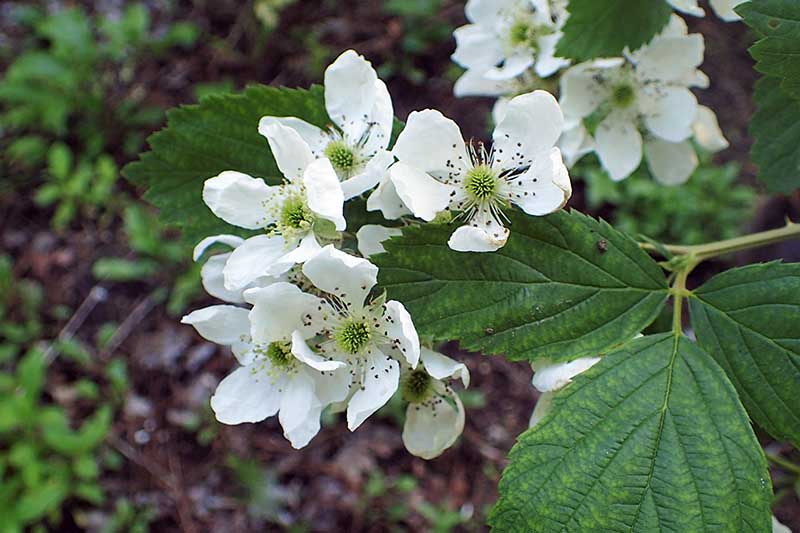
This species blooms with dainty white flowers that are three-fourths of an inch in size, between April and June. R. allegheniensis bears fruit on floricanes from June to August, depending on the region.
The berries are sweet and cylindrical, just three quarters of an inch in size.
R. argutus
Native to the eastern and southern parts of the United States, from Maine to Illinois and Texas to Florida, semi-erect R. argutus also goes by the name sawtooth or tall blackberry, but it doesn’t grow quite as tall as R. allegheniensis.
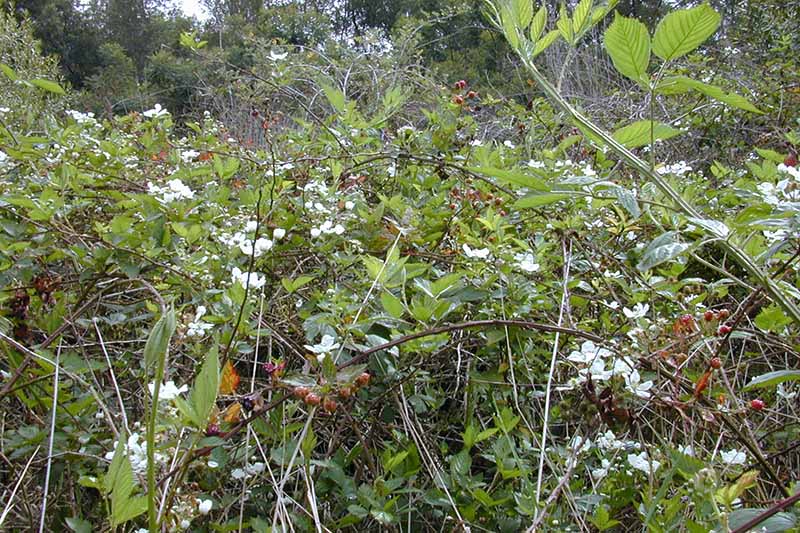
R. argutus reaches between two and six feet tall with a similar spread. The plant blooms in the late spring with white flowers that are three-quarters to one inch in diameter, and bears fruit on floricanes in the summer.
The berries taste tart and lightly sweet, and are two-thirds of an inch long.
R. armeniacus
Known as Armenian or Himalayan blackberry due to its native range in northern Iran and Armenia, R. armeniacus has naturalized all over the world, including in North America after botanist Luther Burbank introduced it here in 1885.
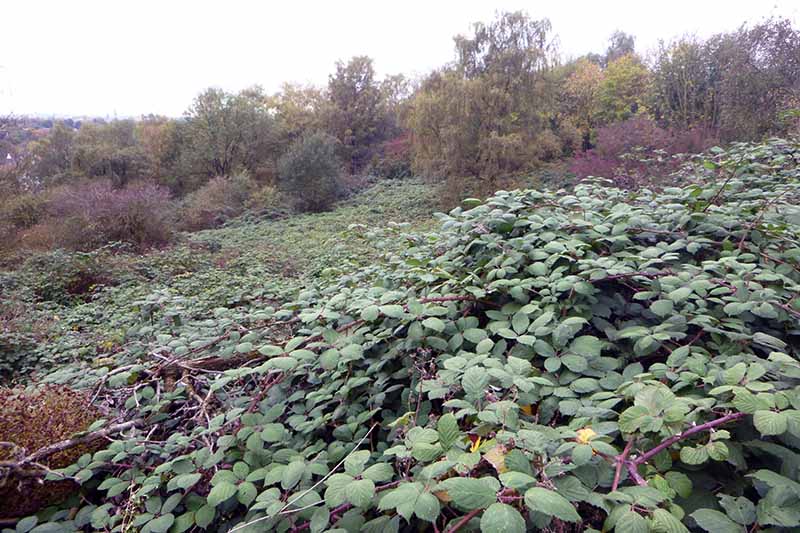
The semi-erect bushes grow up to nine feet tall and can arch back toward the ground, creating a trailing effect.
R. armeniacus is especially prolific in the Pacific Northwest and Canada. Some consider it an invasive species due to its rapid spread, but its berries are some of the largest and sweetest around.
This species blooms with white or pale pink flowers that are three quarters to one inch in size, from late spring to early summer. Fruits develop and mature in mid to late summer and can reach up to one inch in length.
R. laciniatus
Also called cutleaf evergreen or evergreen blackberry, R. laciniatus is easy to distinguish from its counterparts due to its sharp-looking, deeply lobed leaves.
Despite the name, this species is deciduous and has naturalized in much of the western and eastern United States.
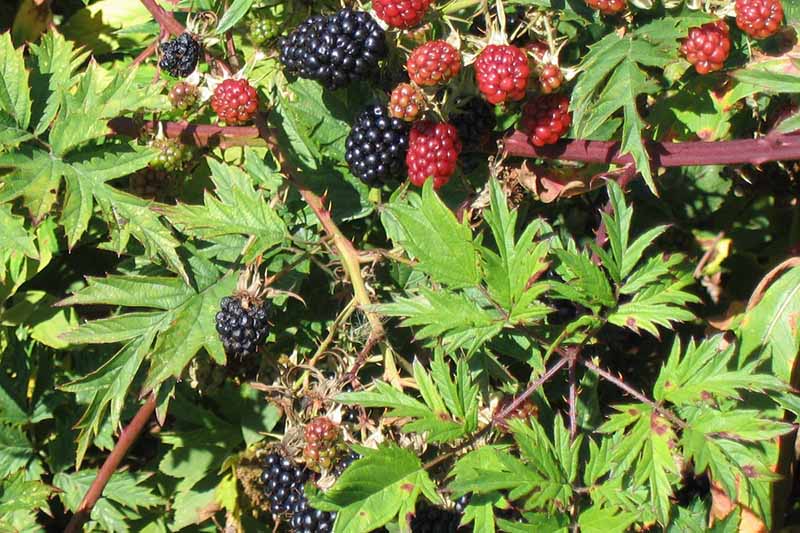
In the Northeast and Pacific Northwest, it’s considered an invasive species, although it doesn’t spread as readily as R. armeniacus. This species is native to somewhere in Eurasia, but the exact location is unknown.
The upright yet sprawling bushes can grow up to ten feet tall with a similar spread. The white flowers are three quarters of an inch long, and they bloom and bear fruit continuously between June and September.
The berries are cylindrical in shape and just half an inch in length. R. laciniatus has been crossed with other species to help create various varieties of commercial blackberries.
R. ulmifolius
Native to North Africa and much of Western Europe, R. ulmifolius is often called the elm-leaf blackberry, a shrubby plant that can grow up to 15 feet tall with a similar spread.

R. ulmifolius is erect when immature and then becomes semi-erect as it grows taller and the canes arch toward the ground.
The flowers, which bloom from May to July, are pink and a quarter to half an inch in size. The oval-shaped, half-inch-long berries come between July and September.
R. ulmifolius has naturalized around the world, including in the Pacific Northwest.
R. ursinus
Native to British Columbia, California, Idaho, Montana, Oregon, and Washington, R. ursinus goes by many names, including Pacific and California blackberry.
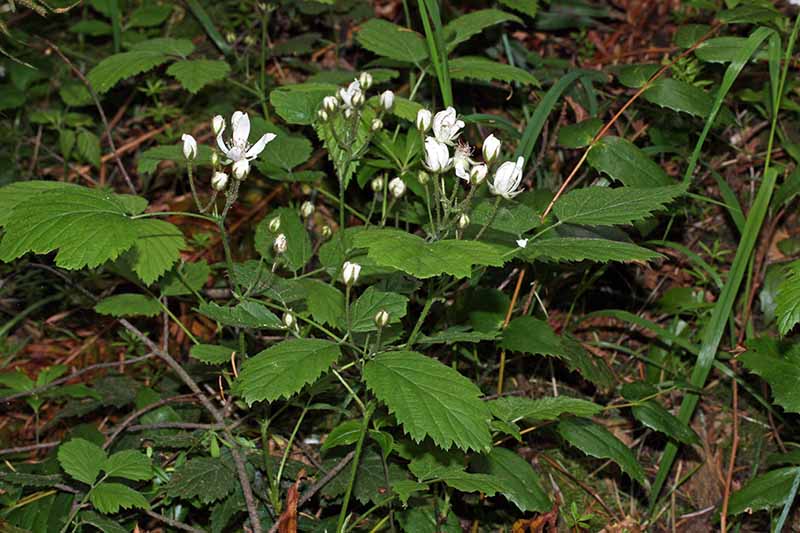
A trailing species, it grows just two to five feet tall and spreads up to six feet.
The white flowers have narrower petals than the other species mentioned here. The plant blooms and sets fruit continuously between March and August.
The cylindrical berries are anywhere from half to one inch in length.
Cultivation and History
These delicious drupelet fruits have long been popular around the world. As you read above, their native range varies widely.
They’ve probably been around for at least 2,500 years; the Haraldskær Woman, a well-studied bog body found in Denmark in 1835, had eaten millet and blackberries shortly before her death in 490 BC.
Scientists discovered this slightly nauseating information during an autopsy on her well-preserved body in 2000.
Lest our taste for blackberries get ruined forever, let’s move on quickly and see what English herbalist Thomas Gerard had to say about these fruits in his 1597 book, Gerard’s Herball:
“The fruit or berry is like that of the Mulberry, first red, blacke when it is ripe, in taste betweene; sweet and soure, very soft, and full of grains: the root creepeth, and sendeth forth here and there young springs.”
If your eyes are ever “hanging out,” fear not, for Gerard says this plant can soothe such a malady: “The yong buds or tender tops of the Bramble bush, the floures, the leaves, and the unripe fruit, being chewed, stay all manner of bleedings. They heale the eies that hang out.”
I recommend you see a real doctor if this ever becomes a problem, of course, but isn’t it fascinating to get a peek into the maladies and treatments of the 16th century?
And if you’re getting tired of your bottle of lotion, your bar soap, or your toothpaste, you can always try Gerard’s all-purpose mix: “The leaves of the Bramble boyled in water, with honey, allum, and a little white wine added thereto, make a most excellent lotion or washing water, and the same decoction fastneth the teeth.”
Indigenous peoples in all the native ranges where blackberries grow have long enjoyed incorporating the berries into their cuisine. They also use the leaves for tea, and the berries make a beautiful reddish purple dye.
Blackberry Plant Propagation
The easiest way to get started growing your own blackberries is to buy a bare root or a young plant from a nursery and put it in the ground.
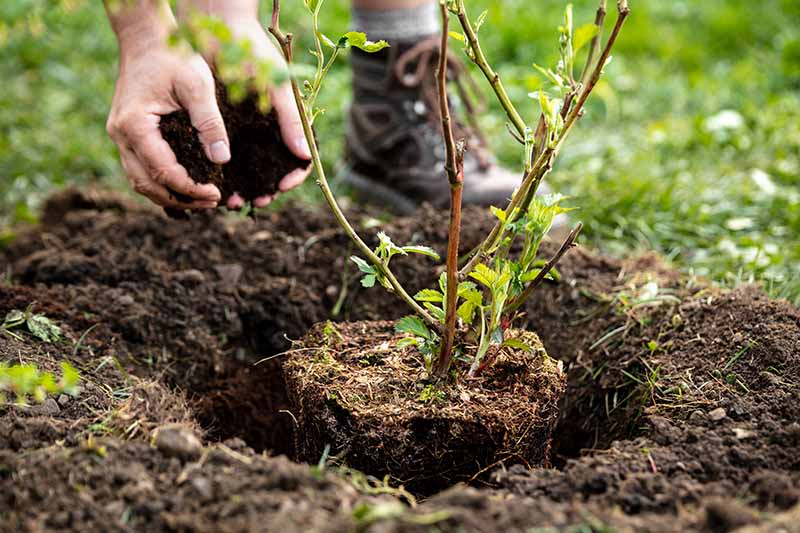
Or, if you already have a plant at home or know a good friend who’d gladly spare a cutting, you can propagate blackberries via stem cuttings or tip layering.
It’s possible to grow these berries from seed, but it’s uncommon to find seeds and it’s simply easier to propagate using a different method.
We’ll cover the four main transplant and propagation methods below:
Bare Root
Most dormant bare roots are sold in late winter or early spring, which is the best time to plant them.
You’ll want to plant your bare root as soon as possible after receiving it.
The moment you get it in the mail or bring it home from a nursery, open the package and carefully place the entire root ball inside a bucket full of room-temperature water to help restore moisture.
Let it soak for up to two hours while you prepare the planting site.
Dig a trench that’s about two to three inches deep and eight inches wide, which will give the roots plenty of space to stretch. Cane berries have shallow root systems, so you don’t need to dig a deep trench.
Add a couple handfuls of well-rotted manure or compost to the planting site to help make the soil richer.
Place your dormant bare root inside the shallow trench and fan out the roots. This will help keep them from getting too knotted together and will promote airflow within the root system as it grows and establishes in the soil.
Backfill the hole with soil and water thoroughly.
While it’s still dormant, only water the plant once or twice a week, or when the soil is dry two inches down.
You should start seeing new, green lateral stems and leaves within four weeks. At that point, increase watering to whenever the top inch of soil feels dry.
From Cuttings
Propagating new blackberry bushes from cuttings is a fun activity to do with the youngest gardeners in your life because it’s easy and straightforward.
First, you’ll need a willing friend with a thriving plant, a sharp pair of pruners, and a few four-inch pots filled with potting mix. You might also want to wear a long-sleeved shirt and gardening gloves to protect your arms from the prickles.
You can take cuttings at any time between spring and fall, when the plant is actively growing.
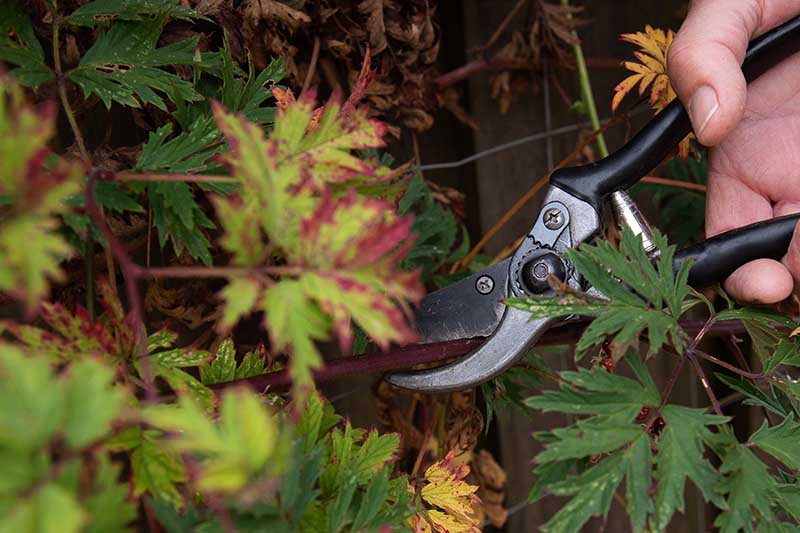
Find a length of primocane, which is that green first-year growth without flowers or fruits, and cut a four- to six-inch section of the cane.
You’ll want to take at least two to three cuttings to help ensure your chances of success.
Remove the leaves from the bottom inch or two of each cutting, and bury each one about two inches deep in the potting mix. Once each cutting has a home, water slowly, until water runs out the bottom of the pot.
When new leaves begin to grow, you’ll know your cuttings have rooted. This should happen within about four to six weeks from the time you take the cuttings.
After they’ve rooted, you can transplant them into eight-inch pots in potting soil amended with well-rotted compost or manure, or with 20-20-20 NPK fertilizer according to package instructions.
Tip Rooting
In the wild, these brambles easily spread via underground rhizomes and by natural tip layering, or tip rooting. Tip rooting happens when the vine of a trailing or arching cane berry touches the ground.
The vine grows roots where it touches the earth, much like a strawberry sends out runners to root new little plants here and there throughout a berry patch.

To mimic natural tip layering, prepare a four-inch container with potting mix and carefully bend a vine or two from a primocane until the tip of it touches the mix.
Cover about two inches of the tip with soil. If it won’t stay put, place a small stone on top of the vine to keep it in place.
Water the buried tip about once a week, or more often if the soil dries out one inch down.
Within a couple weeks, you should be able to remove the rock and notice that the cane is staying in place. It’s got new roots!
Cut the cane away from its mother plant about a foot away from where it rooted in the pot. Now you have a plant that you can give to a friend or put in the ground. Be sure to transplant it at least three to five feet away from the parent, as described below.
Transplants
For this easy method, all you need is a new, live plant and a full-sun location to put it in.
Dig a hole as deep and wide as the root ball of the live plant and add a couple handfuls of well-rotted manure or compost to the hole. Blend this with the existing soil.
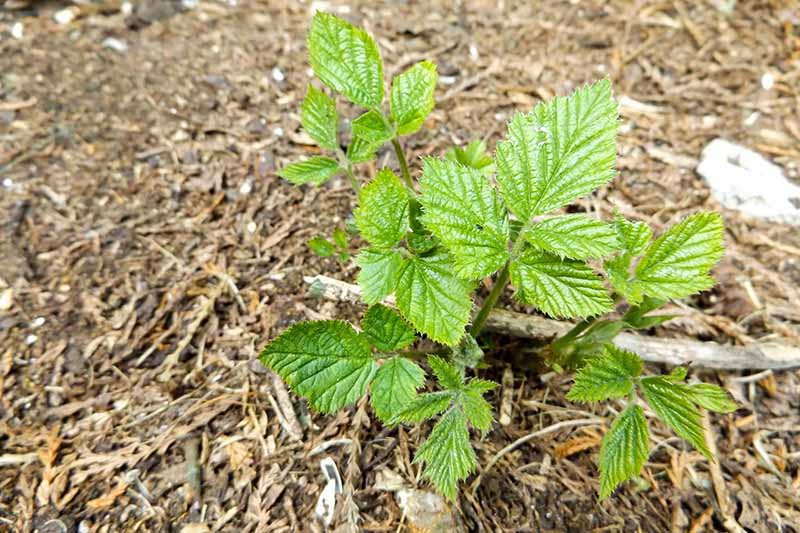
Carefully remove your plant from its container and set it in its new home. Backfill with soil and water thoroughly.
Water again whenever the top inch of soil dries out.
How to Grow Blackberries
Every spring, you’ll want to give established plants one dose of 20-20-20 NPK fertilizer according to package instructions. Read our guide to fertilizing blackberries for more info on feeding your plants.
Your plants will need water one or two times a week in the absence of rain, or whenever the top inch of soil dries out.
You’ll find that once fruits begin to form, the plant takes up more water than usual, and you’ll need to increase watering accordingly.
Make sure to avoid overhead watering as much as possible. This will help keep your valued plants from falling victim to various fungal diseases.
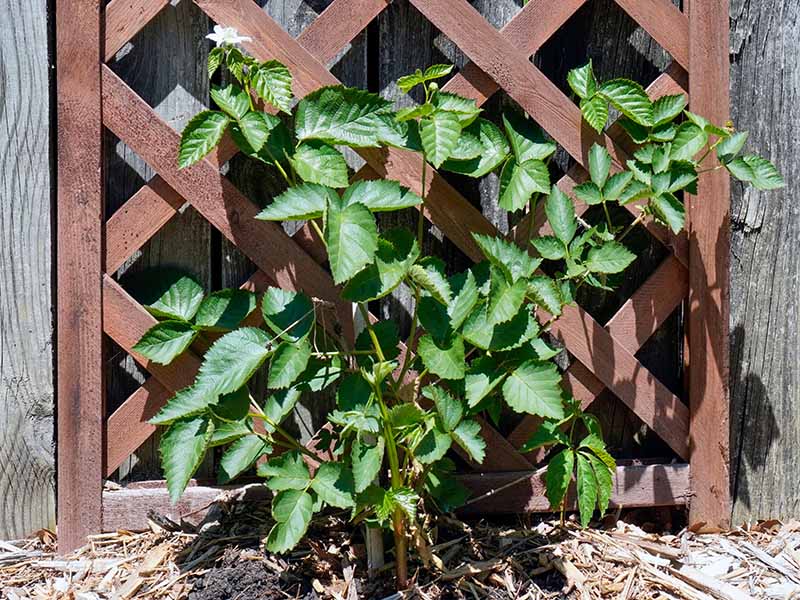
Depending on whether you’ve planted erect, semi-erect, or trailing varieties, you may need to grow your vines against a trellis for support.
Those of us who live in colder areas should mulch with dark-colored material to preserve warmth and moisture.
Those of you who live in warmer climes can mulch with light-colored material to deflect a bit of heat from the sun and keep the roots cool and moist.
In the winter, cover the entire plant with straw. If you live in an area where it snows, the snow will cover the straw and make a fantastic insulation against brutally cold weather.
Growing Tips
- Water once or twice a week, or whenever the top inch of soil dries out.
- Mulch to help provide even moisture and keep the plant cool or warm, depending on where you live.
- Cover with straw in the winter when dormant.
- If you are low on space, try growing your berries in containers.
Pruning and Maintenance
Blackberries require just a bit of trimming to keep them healthy and happy.
Each spring, you’ll need to prune the central primocanes of each plant to three or four feet in height.
This will encourage the plant to focus its energy on growing laterals. But you’ll need to trim those as well, back to about twelve inches in length.
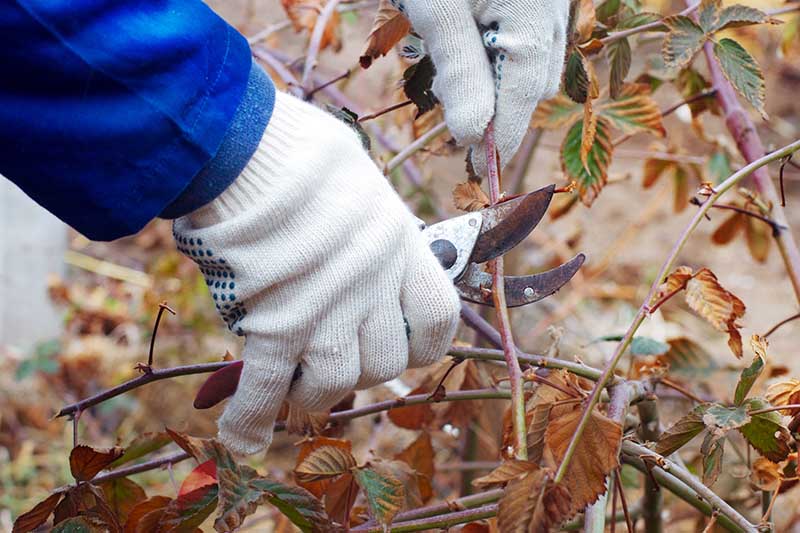
As the plant goes dormant and temperatures dip in late fall or early winter, it’ll be pruning time again.
Cut the spent floricanes down to the ground to get them out of the way. Trim the central primocanes to three to four feet again, and the laterals back to about 12 to 15 inches.
Read more about pruning your blackberries here.
Blackberry Cultivars to Select
There are dozens of cultivars to choose from when it comes to blackberries. Here are a few of our favorites to kickstart your adventure into growing these tart fruits.
Arapaho
Do you want a thornless, erect cultivar that produces a robust crop of sweet, one- to two-inch-long berries?
Look no further than ‘Arapaho,’ a popular variety cultivated by breeders at the University of Arkansas in the early 1990s.
‘Arapaho’ is hardy in Zones 5 through 7, reaches a mature height of four to six feet, and spreads three to four feet.
Even better, this cultivar blooms with pink and white flowers in mid spring and produces fruits that ripen in mid-June. It’s one of the earliest-maturing blackberry cultivars available.
Start your berry patch off strong with a pack of three bare root plants, available from Nature Hills Nursery.
Darrow
If you love the idea of a trellis wound through with blackberry vines, ‘Darrow’ is the classic, trailing cultivar for you.
This disease-resistant cultivar grows up to three or four feet in height and width, and climbs a trellis beautifully.
It’s hardy in Zones 5 through 8. The floricanes bloom with white flowers in April and early May and produce tart, lightly sweet berries – which are said to taste a lot like those you’d find in the wild – in June, July, and August.
The long picking season will have you forgiving the thorns on ‘Darrow.’ The berries are about three quarters of an inch to one inch in length.
Start your berry-growing adventure with bare root plants from Nature Hills Nursery.
Prime-Ark Freedom
If you’re impatient, like I am, this primocane-fruiting cultivar is a perfect pick.
Bred and released to the public by plant breeders at the Agricultural Experiment Station at the University of Arkansas in 2013, ‘Prime-Ark Freedom’ is an erect, thornless variety that gives you a crop in the first year.
Even better, ‘Prime-Ark Freedom’ is pest and disease resistant. Hardy in Zones 6 through 8, this cultivar grows up to five or six feet in height and spread.
It blooms with pink and white flowers in early to mid spring. The heavy, one- to two-inch-long berries ripen in July or August for primocane-borne fruits, and June for floricane-borne fruits.
This means that in the second year, you’ll get two crops of berries: one in early summer and one in late summer!
Find bare roots or live plants for your blackberry patch available from Burpee.
Managing Pests and Disease
Blackberries can fall prey to a variety of pests and diseases, but by avoiding overhead watering, using only healthy and disease-free stock, and cleaning gardening tools before using them to plant your berries, you’ll avoid a host of problems.
Pest and disease resistant cultivars abound, too, further helping to keep your plant healthy. But we’ll take a quick look at some of the more common issues to watch for.
Pests
You probably won’t experience too much drama with pests. While blackberries can sometimes suffer from aphid infestations, these don’t tend to happen often and can be easily treated with insecticidal soap or neem oil spray.
Redberry mites (Acalitus essigi) are a peskier problem, as they’re microscopic. The only way to know that they’ve infested a plant is that some drupelets never mature to a black color like they should, though other drupelets do.
Remove the affected fruits and spray the rest of the plant with a horticultural miticide oil, like this one by Monterey, available from Arbico Organics.
Even some of the more notable pests, like spotted wing drosophila (Drosophila suzukii), which looks like a pale orange-yellow fruit fly, and Japanese beetles (Popillia japonica) don’t cause lasting damage if caught and managed early.
Spotted wing drosophila infests individual berries, depositing white larvae inside. Ew! To test for these, drop a berry in warm saltwater.
After half an hour, check the surface of the water. If you see small white maggots floating on the top, you have an infestation.
If you find an infested berry during the saltwater test, you’ll also want to check a berry from each lateral branch to see if it’s infected with maggots. If so, remove and destroy the affected branch.
Japanese beetles skeletonize the leaves, as well as eating flowers and ripe fruits. They’re about half an inch long with copper wings and green bodies.
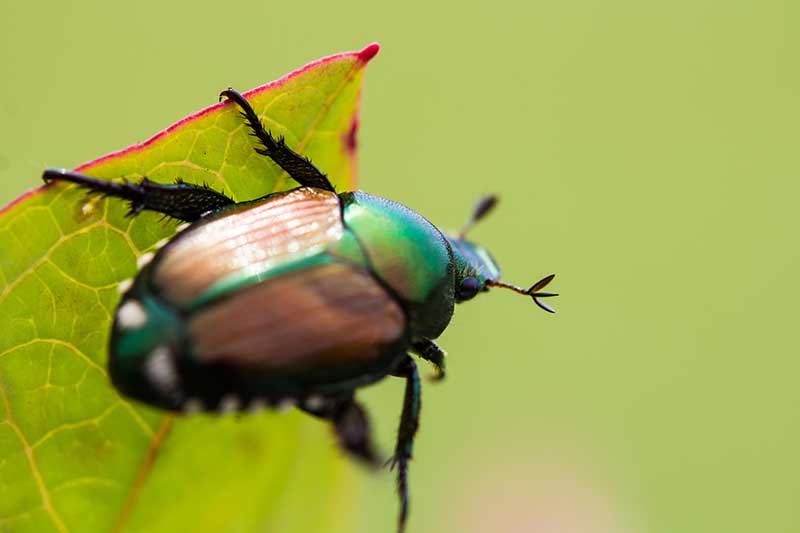
At the first sign of Japanese beetle damage, remove affected foliage and spray the entire plant with PyGanic, a botanical pesticide made with pyrethrum.
Pyrethrum is extracted from daisies and does wonders to get rid of beetles.
PyGanic is available from Arbico Organics.
Disease
One common disease is anthracnose, which is caused by the fungus Elsinoe veneta and results in whitish-gray lesions that develop on young, actively growing canes and leaves.
An infection can also cause cane death, leaf drop, and low yields.
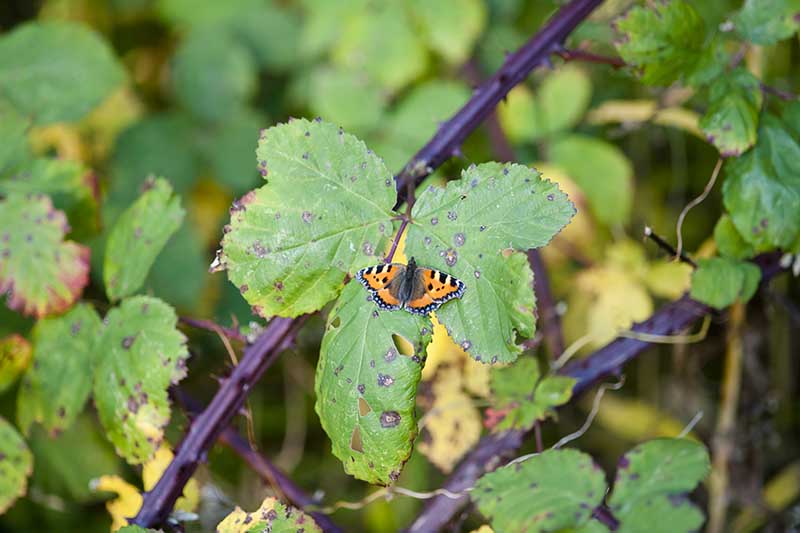
Avoiding overhead watering goes a long way toward preventing this moisture-loving fungal disease.
If you notice symptoms of anthracnose on your plants, remove affected canes and spray the plant with a copper fungicide, like this one from Bonide that’s available via Arbico Organics, according to package instructions.
Another plague that may affect your plants is orange rust, caused by the fungus Gymnoconia peckiana. In new growth, orange rust manifests as weak shoots with pale green or yellow leaves.
Within a few weeks, orange pustules form on the stems and leaves.
If you can identify orange rust and remove and burn the entire affected plant before the pustules burst open, releasing spores into the wind to infect your other brambles, you’re in luck.
Orange rust affects a plant from the root system on up, and while it won’t kill a plant, it’ll prevent fruit from forming. There’s no point in keeping rust-infected cane berries around.
Since wild blackberries are more susceptible to these diseases, it’s in your best interests if you are growing a cultivated crop in your garden to uproot and destroy any nearby wild Rubus plants, including raspberries and dewberries, to help prevent the spread of disease.
Other diseases that affect these cane berries are crown gall, witches’-broom fungus, and algal spot.
Harvesting and Preserving Blackberries
Harvesting blackberries is the easiest part of the whole growing experience.
All you have to do is wait until the berries have turned from red to deep purplish black, get a pair of gloves if you’re growing a prickly variety, and head into the garden with a bucket.
You can pick them at any time, but early morning is ideal since the day’s heat hasn’t had a chance to soften or stress out the plump berries.

Pull all the ripe blackberries that you can off the vine and let them plunk into your bucket. And remember to pop a few into your mouth, too!
If you don’t use your harvest right away, refrain from washing the blackberries.
Store them in the refrigerator in a shallow container covered with plastic wrap punctured with two or three holes. Eat them within three to six days.
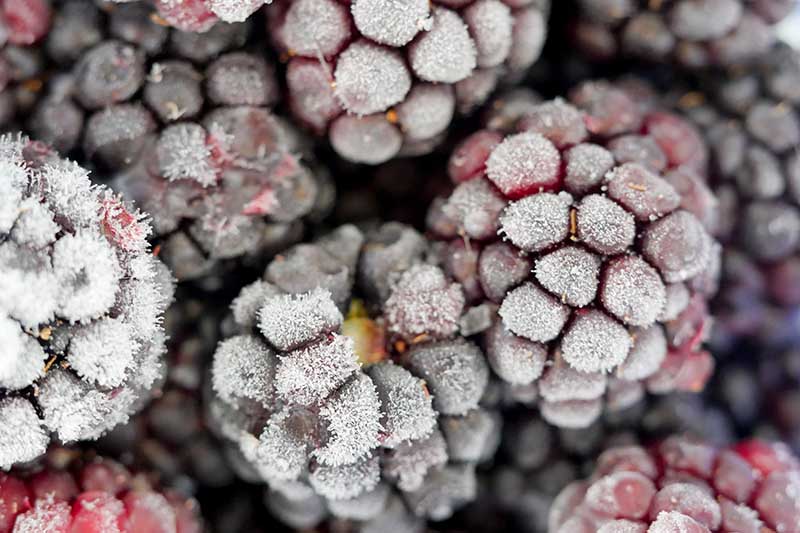
For a longer storage time, you can freeze your blackberries. Gently wash them in cool water, pat them dry with paper towels, and spread them on a baking sheet in a single layer.
Put them in the freezer for several hours. Once they’re frozen, transfer the berries into a ziptop bag and put it back in the freezer.
Frozen berries will last for up to a year!
Recipes and Cooking Ideas
There’s truly no limit to what you can dream up with a homegrown fresh or frozen harvest of blackberries. Toss them into a smoothie or make them into jam.
Or, if you’re like me and love to bake, make these delicious scones from our sister site, Foodal.
There’s nothing better than one of these scones paired with a cup of coffee on a brisk spring morning.
For dinner, invite your friends over and serve these refreshing blackberry-lemon cocktails, also from Foodal.
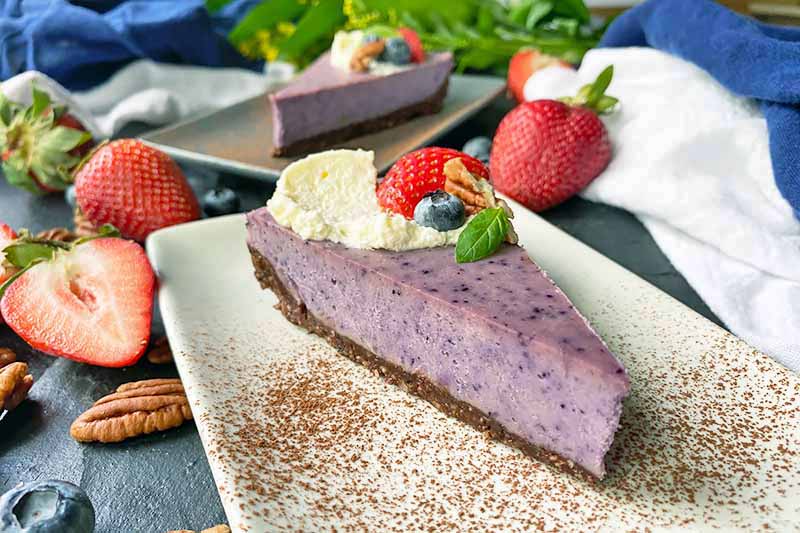
At dessert, please your gluten and dairy-free guests with this raw berry cream pie from Foodal.
And you can always do the classics, too: cobblers, crisps, pies, parfaits, and whatever suits your taste buds. No matter how you eat your blackberries, each bite will be a reward because you grew them yourself.
Quick Reference Growing Guide
| Plant Type: | Perennial berry | Tolerance: | Frost |
| Native to: | Eurasia, Europe, North Africa, North America | Maintenance: | Medium |
| Hardiness (USDA Zone): | 4-9 | Soil Type: | Loose and organically rich |
| Season: | Spring, summer | Soil pH: | 5.5-7.0 |
| Exposure: | Full sun | Soil Drainage: | Well-draining |
| Time to Maturity: | 1 years | Companion Planting: | Lemon balm, mint, peas, tansy |
| Spacing: | 3-5 feet | Avoid Planting With: | Eggplant, peppers, potatoes, raspberries |
| Planting Depth: | 2 inches, depends on style of propagation | Order: | Rosales |
| Height: | 3-10+ feet | Family: | Rosaceae |
| Spread: | 3-10+ feet | Genus: | Rubus |
| Water Needs: | Moderate | Species: | Allegheniensis, argutus, armeniacus, fruticosus agg., laciniatus, ulmifolius, ursinus |
| Common Pests: | Aphids, Japanese beetles, redberry mites, spotted wing drosophila | Common Diseases: | Algal spot, anthracnose, crown gall, orange rust, witches’ broom fungus |
Blackberry Bliss
Congratulations! You’re now equipped with all the information you need to go forth and plant the blackberry patch of your dreams.
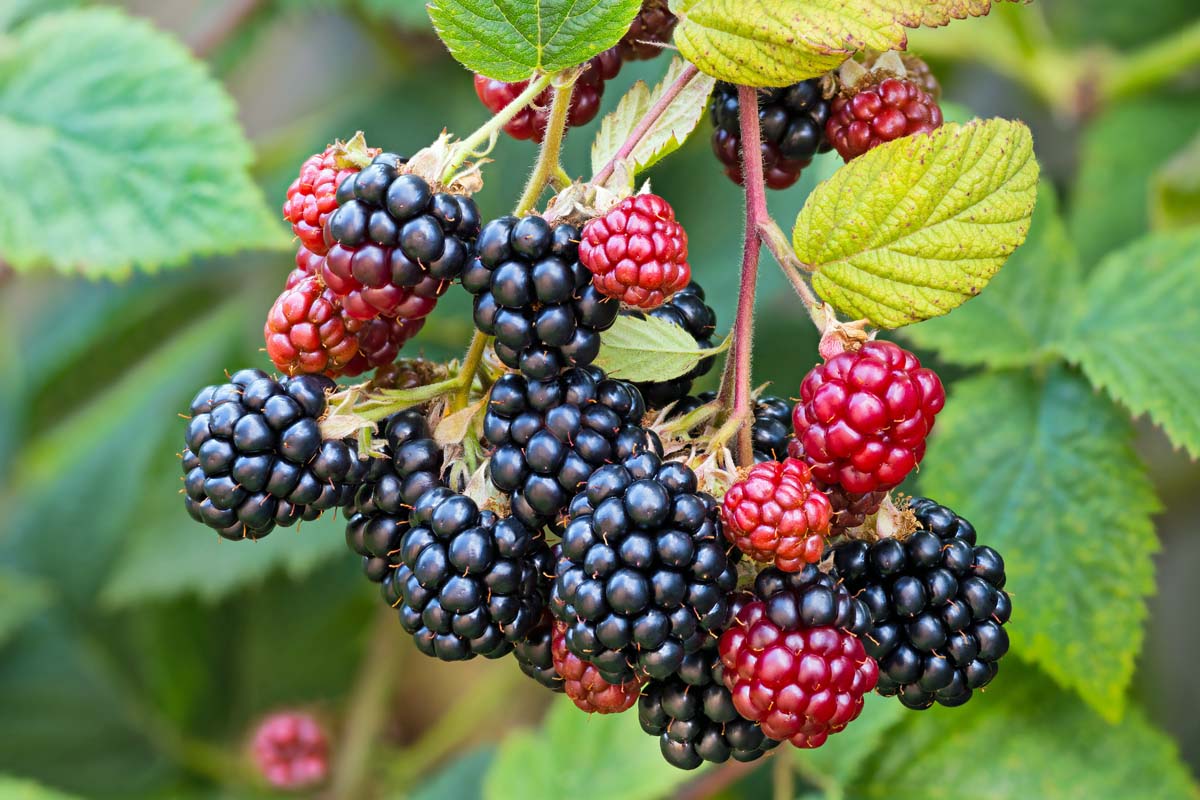
But if you run into any issues, or have questions or stories to share, drop us a note in the comments section below. We love to hear from you!
And in the meantime, for more information on growing tasty berries in your garden, check out these guides next:

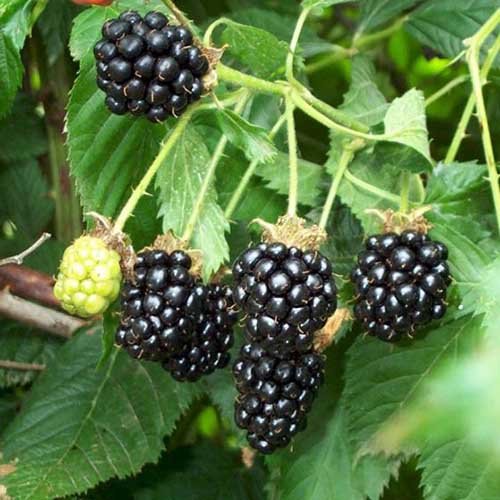
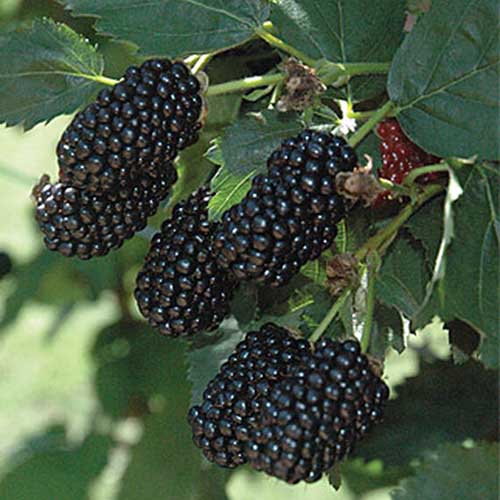


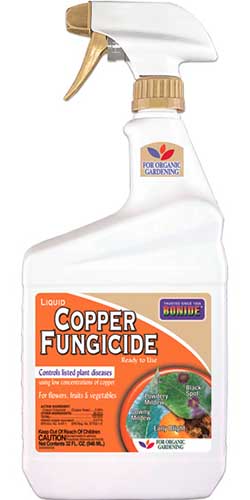
Dear Laura,
Your article on Blackberry plant care is comprehensive and highly enlightening to me who lives in the Southern tip of India where the climate is mixed with heavy Monsoon rain, hot and humid in the summer and cool at night in the months Nov-Dec. I too grow a Blackberry plant, am hoping to see it flower and fruit some day. Thank you and Take Care.
Hi George,
That sounds like near-ideal blackberry conditions to me! Thank you so much for reading, and let me know if you have any questions as you cultivate that blackberry plant. Take care!
I believe my thornless blackberries are semi erect. I did not prime out the florocane from last year and they have flowered and some have berries forming. It appears these berries will be smaller.
Is this common? The very tips are dead however.
Thanks for the great article! I was wondering if I should be pruning my new growth now that I’ve cut the old primocanes down to the ground and found my answer. I can hardly wait to see what other info you have on your site.
Can I grow the blackberry in a big tub or pot?
Hi Bryce, you absolutely can grow blackberries in containers, check out our guide to learn more about the process. Happy gardening!
Can I grow blackberries on a telephone pole? I THINK I have Rubus hispidus L., or Running Blackberries. I am in north Georgia but brought them from central Oklahoma.
just bought Darrow B B and after 3 weeks im not seeing any buds sprouts or anything of the plants am i doing or not doing in the planting yes there in full day light from sun up to sun down I live in Elizabethtown KY plant size #1-2 yr hight 3 to 6 ft should I take up and replace I need Help thank you
Hi Rowland, I wouldn’t worry just yet. The first year after planting, some plants just take their time to become established and start growing. I have a blackberry that took a full year to send out new growth. As long as there isn’t any evidence of disease or stress like yellowing or brown foliage, I wouldn’t replace it.